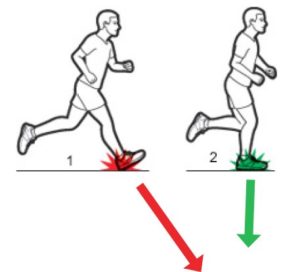Over-striding is a common running mistake seen in distance runners.
This running fault (image 1 below) occurs when an athlete makes contact with the ground too far in front of their center of gravity, which increases shock and decreases performance.
Ideal initial contact should occur under a runner’s center of gravity (image 2 below) and will reduce the chance of injury and improve performance.

The following are five ways to reduce over-striding:
- Increase forward lean: Runners who over-stride tend to run very upright and some even lean back slightly. Leaning forward from the hips 8 to 10 degrees, will reduce the likelihood of over-striding as well as activate the glutes for a more powerful stride.
- Increase running cadence: Over-striders typically run with a slower cadence (130 to 160 steps per minute), which increases ground contact time. Increasing your running tempo to the ideal 180 steps per minute (90 strides per minute) shortens contact time and brings initial contact under the center of gravity. Using a metronome or an app such as Rock My Run, can help gradually increase running cadence.
- Practice A-Skips: An A-Skip is a running drill commonly used during track where a runner runs with an exaggerated knee lift and toe lift, but more importantly, focuses on driving the foot down to the ground. By driving the foot down to the ground, contact occurs under the center of gravity and the muscles of the posterior chain (glutes, hamstrings, and calves) are activated and lead to a more powerful stride.
- Include uphill intervals: It is nearly impossible to over-stride while running uphill. Adding uphill intervals, which consist of running four to seven sets at a 4 to 5 percent grade for three minutes at tempo pace with a two-minute rest, will help you practice making proper contact with the ground under your center of gravity.
- Finish with barefoot strides: Over-striders generally land on their heels, and when you run barefoot, you will naturally run with a midfoot strike. So, following an easy run, perform three to five sets of barefoot strides of 50 to 100 meters at 60 to 80 percent of top speed. Not only will barefoot strides help you with improving your stride mechanics, but they will increase foot strength and overall mobility.
If you are looking to improve running performance and decrease your chance of injury, undergo a running evaluation or have someone video your running technique. If you discover that you are over-striding try some of the methods listed above to fix your form. Sanford POWER performs running evaluations with high-speed video and offer other services that can help you perform at your best.
Learn more
- Hip fatigue late in the race? Here are some solutions
- Fit for Fargo: IT band syndrome
- Shin splints: ‘Too much, too soon’ injury
…
Posted In Health Information, Orthopedics, Running, Sanford Sports
